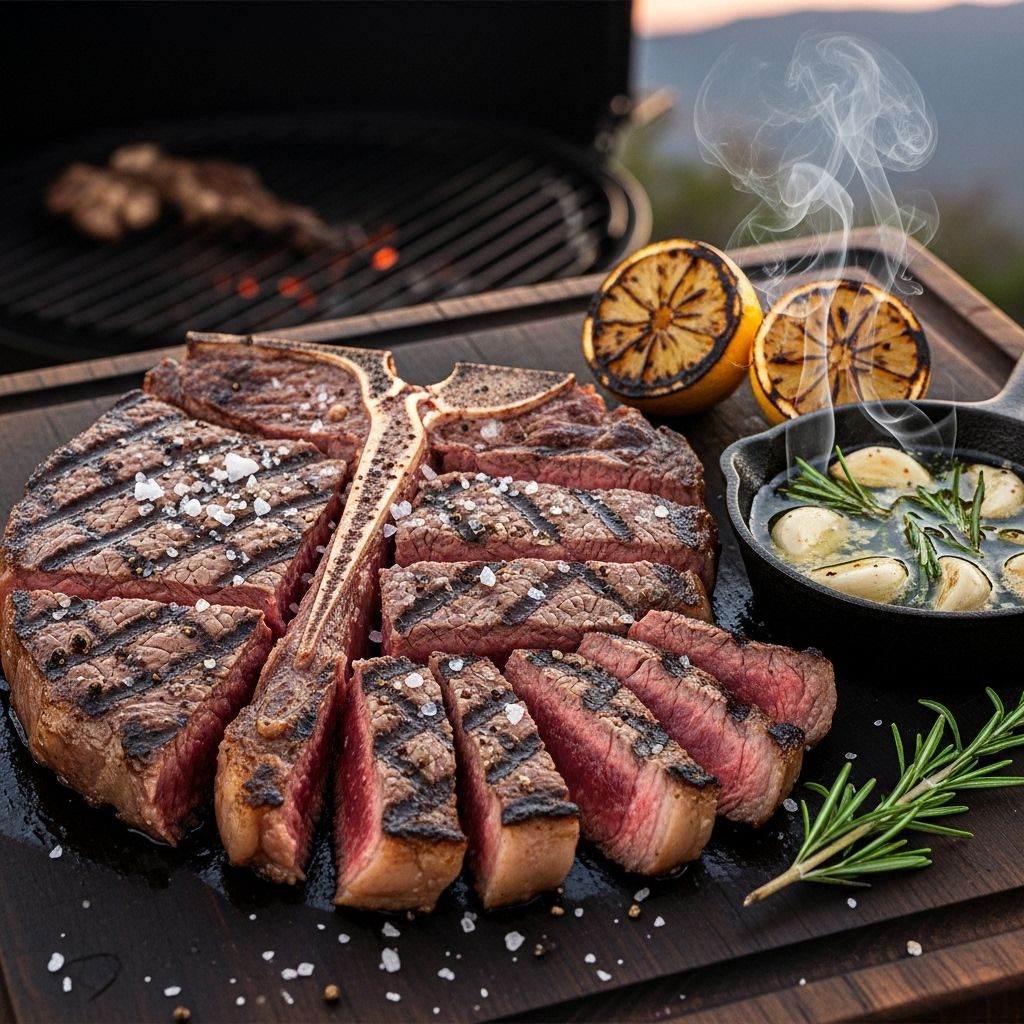The Ultimate Guide to Perfect Grilled T-Bone Steak: Techniques & Tips
Achieve consistent crust and juicy interior with reverse-sear and two-zone setup.

The Ultimate Guide to Perfect Grilled T-Bone Steak
If you’re searching for flavorful, tender, and professionally cooked T-bone steak at home, this guide will walk you through every essential detail. Combining expert culinary techniques, temperature management, and a step-by-step grilling plan, you’ll learn how to consistently achieve steakhouse-caliber results.
What Makes T-Bone Steak Unique?
The T-bone steak stands out in the world of beef due to its two distinct sections divided by a T-shaped bone:
- Tenderloin/Filet: The smaller, supremely tender portion (often referred to as filet mignon).
- Strip Steak/New York Strip: The larger, beefier side offering classic steakhouse flavor.
This duality gives the T-bone exceptional appeal to home grillers and steak lovers alike. However, it also presents a challenge: both sections cook at different rates, demanding careful technique for a perfect result.
Essential Equipment for Grilling T-Bone Steak
- Charcoal or Gas Grill: For high, direct heat and easy control.
- Instant-Read Thermometer: Ensures precise doneness (essential for pro results).
- Tongs: For turning steaks without piercing or losing juices.
- Heavy-Duty Aluminum Foil: Useful for resting.
- Chimney Starter (for charcoal): Enables quick, even lighting of coals.
Choosing the Right T-Bone Steak
Select steaks at least 1.5 inches thick for best grilling results. Thick steaks prevent overcooking and allow for the classic combination of charred exterior and juicy middle. Look for:
- Bright Red Color: Indicates freshness.
- Ample Marbling: Fine streaks of intramuscular fat ensure flavor and juiciness.
- Creamy White Fat: Edge fat should be firm, not yellowed.
Preparing Your Steak for the Grill
- Bring Steak to Room Temperature: Let the meat sit out for 30–45 minutes prior to grilling. This promotes even cooking.
- Season Generously: Use kosher salt and freshly-ground black pepper. Seasoning ahead (at least 40 minutes prior) allows salt to penetrate for enhanced flavor and tenderness.
- Optional: Oil the Steak: Lightly brush with neutral oil (e.g., canola) for enhanced exterior browning.
Step-by-Step Grilling Method
1. Set Up a Two-Zone Fire
Two-zone grilling is key for perfect doneness:
- Direct Zone (Hot): Where you’ll sear and create crust.
- Indirect Zone (Cooler): Used for gentle cooking and controlling doneness.
2. Strategic Placement
Start the steak over indirect (low) heat with the tenderloin side away from the hottest part of the grill. This protects the delicate filet portion from overcooking while the strip side absorbs more heat and flavor.
3. Reverse Sear Technique
Reverse sear involves gently cooking steak first to bring it just shy of desired doneness, followed by a final blast of high heat for a smoky, caramelized crust. This technique delivers superior juiciness and texture.
- Begin on the cool zone until steak reaches about 90–95°F internally.
- Move to the hot zone and sear for 1–2 minutes per side until a deep brown crust forms (flipping every 30–40 seconds maximizes even browning).
4. Monitoring Doneness with a Thermometer
Pull the steak from the grill when its internal temperature is 10°F (6°C) below desired doneness; carryover cooking off the grill will finish it perfectly.
| Doneness | Pull Temperature | Final Meat Temperature |
|---|---|---|
| Rare | 115–120°F | 125–130°F |
| Medium-Rare | 120–125°F | 130–134°F |
| Medium | 126–135°F | 135–144°F |
| Medium-Well | 136–145°F | 145–154°F |
| Well | 146+°F | 155+°F |
Use a fast, accurate thermometer for best results. The “thumb press” or guessing simply isn’t reliable.
Resting the Steak
Transfer steak to a cutting board and loosely tent with foil. Let rest for 5–10 minutes before slicing.
- This allows juices to redistribute, ensuring each bite is moist and flavorful.
- Resist the urge to slice immediately; patience pays off.
Serving Suggestions and Finishing Touches
- Optional Compound Butter: Add a slab of garlic or herb butter atop the hot steak for a luxurious finish.
- Fresh Herbs: Sprinkle with fresh thyme, rosemary, or parsley.
- Side Dishes: Pair with grilled vegetables, a crisp salad, or roasted potatoes.
- Slicing Tips: Separate the tenderloin and strip sections along the bone, then slice against the grain for optimal tenderness.
Troubleshooting: Common Mistakes & Solutions
- Steak Too Thin?
If your steaks are less than 1 inch thick, reduce grilling time and focus on searing fast over high heat to avoid overcooking. - Dried Out Steak?
Underseasoning or not resting properly can minimize juiciness. Always season well and rest sufficiently. - Tough Tenderloin?
Keep tenderloin section away from direct heat for most of cooking. Consider shielding with foil for extra protection. - Flare-Ups?
Move steak temporarily to the cooler zone if flames erupt; replace if heat subsides.
Expert Tips for Perfect Grilled T-Bone, Every Time
- Flip Frequently: Turning steak every 30–40 seconds promotes even browning and minimizes burning.
- Shield Fillet Side: Position the fillet away from the fire’s hottest region, protecting texture and preventing overcooking.
- Patience with Searing: Let crust develop; do not rush or constantly move steak during final sear.
- Monitor Temperature Carefully: Use a quality thermometer—do not rely on visual cues alone.
- Let Steak Rest: This is crucial for flavor and texture; give steak sufficient time before carving.
Frequently Asked Questions (FAQs)
Q: Why does the tenderloin often cook faster than the strip?
A: The tenderloin is thinner and has less connective tissue than the strip, making it cook more quickly. This is why it should be kept away from the direct heat source wherever possible.
Q: What’s the fastest way to check steak doneness?
A: Use a fast, instant-read thermometer. Guesswork is unreliable, and “feel” techniques can lead to inconsistent results.
Q: What does reverse sear mean?
A: Reverse searing involves slowly bringing the steak to temperature over indirect heat, then finishing with a hard sear over direct heat for a perfect crust and interior.
Q: Can I use a gas grill instead of charcoal?
A: Yes, the same two-zone technique (one hot, one cool) works on gas grills. Use high heat for searing and a cooler area for initial cooking.
Q: How do I get restaurant-level results at home?
A: Use thick steaks, season properly, control temperatures precisely, employ the two-zone and reverse sear method, and rest steaks before serving.
Quick Reference Table: Grilling Temperatures & Times
| Doneness | Pull Temp | Total Cook Time* | Searing Time |
|---|---|---|---|
| Rare | 115–120°F | 8–10 min | 1–1.5 min/side |
| Medium-Rare | 120–125°F | 10–12 min | 1.5 min/side |
| Medium | 126–135°F | 12–14 min | 2 min/side |
*Varies by steak thickness and grill intensity
Conclusion
Grilling a T-bone steak successfully requires attention to detail, from the thickness of your cut to the precise monitoring of temperature, and favoring techniques like the reverse sear and two-zone setup. Whether using gas or charcoal, following these steps will deliver a steak experience that rivals the best steakhouses—at a fraction of the cost, and with total control over your preferred doneness. Embrace these methods for memorable meals and share the love of perfectly grilled steak with family and friends.
References
Read full bio of Shinta












